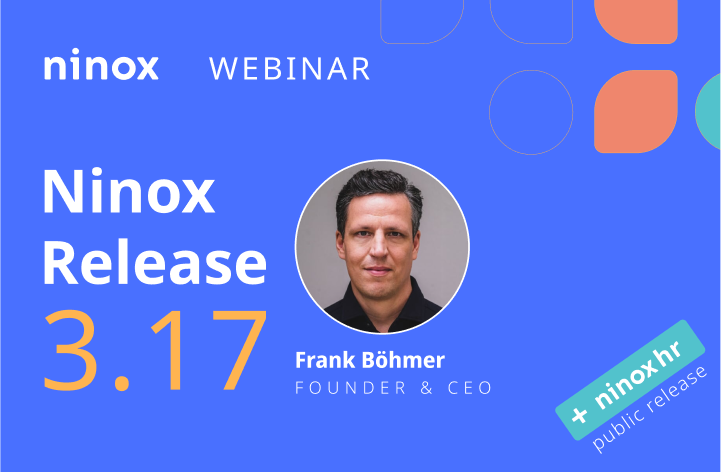How to create an employee database and work more efficiently

- What is an employee database?
- How can an employee directory be created?
- Why is the employee database important for companies?
- The challenges without a central employee database
- What are the benefits of an employee database?
- Create an employee database: These points are particularly important
- Creating an employee database: How Ninox supports
- Conclusion: Make employee management efficient and flexible thanks to the database
The most important resource for HR managers is data from their own employees. Without an orderly structure, payroll, vacation permits or deployment planning become a jumbled task. A structured employee database serves as a central tool and also ensures that employee information is stored in accordance with data protection regulations.
In this blog post, you can find out what data an employee database contains, what benefits it offers and how Ninox helps you create an employee directory.
What is an employee database?
In an employee database (also: employee directory), all necessary information about the employees of a company is compiled, stored and managed. It is often part of HR software and therefore serves various areas of responsibility, such as application management, payslips, vacation planning or expense management. The employee database records information such as:
- Last name, first name
- Staff number
- Address, email, and phone number
- department
- position
- salary
- Start date (possibly cancellation)
- Social security number
- tax number
The data varies from company to company depending on industry, size, and company structure. It is important that the information is relevant for personnel administration. Additional fields can also be used to record special information — such as special abilities, disabilities or work events.

Important to know: All data collected in an employee database is subject to the General Data Protection Regulation (GDPR).
How can an employee directory be created?
Employee databases can be implemented either as a physical list or as a digital database (ideally using cloud software). In times of digitization, physical lists in personnel files are less common today and not recommended.
By contrast, with the help of digital employee directories, HR managers can react quickly, as all information is stored at a central location. Subsequent changes or additions can be transferred to the digital employee database without spending much time.
Why is the employee database important for companies?
Medium-sized and large companies in particular find it difficult to keep track of all employee data. Outdated systems such as handwritten personnel files are neither up to date nor do they have a positive influence on efficiency in personnel management.
A digital, central employee database, on the other hand, provides a structured overview and thus makes everyday work easier for HR professionals. Deployment planning can be carried out digitally using the database and is also accessible to everyone. Spontaneous assignments are easier to manage, as availability can be easily retrieved from the employee database. Special abilities can be added by employees in additional fields. If these special skills are required during an assignment, personnel managers can use the employees in a targeted manner. This increases the company's overall productivity.

The employee database is also particularly important when it comes to payslips. For example, by keeping working time accounts, statements can be created at the push of a button. Processes such as vacation requests or sick leave can also be automated. Employees have independent access to their applications, which simplifies communication. The employee database thus also creates transparency in communication between employer and staff during all bureaucratic processes.
The challenges without a central employee database
One of the biggest challenges with loose personnel management is missing structure. While the data is sorted in a central employee database, companies without a system lack such an organization. Working hours cannot be effectively evaluated because time sheets are written by hand and must be evaluated by each individual employee. This results in a lot of paperwork.
Another challenge is inefficient processes. Since not all information about their own employees is queried centrally, HR managers often do not know their employees correctly. Without this information, there is no knowledge of the staff's abilities, which in turn leads to a poor deployment planning leads, which results in unnecessary costs.
Companies that store employee data in lists such as Microsoft Excel are already one step ahead. However, there is also a risk of inconsistent data setsbecause information can be lost quickly. There are no specific access rights that provide the data with the necessary security. An even more important challenge
What are the benefits of an employee database?
In the modern world of work, the use of an employee database plays a decisive role in optimising work processes and promoting effective collaboration within the company. In the following, we will show you the various advantages of such a database:
- Effective collaboration: With an employee database, teams can be put together more easily and projects can be staffed with suitable personnel in a more targeted manner. This promotes effective collaboration.
- Transparent communication: The database provides a 360-degree view of the entire staff and makes it easier to access information such as project assignments and contact details. This makes communication within the company more transparent.
- 360 degree view of the staff: The central storage of employee data provides a comprehensive overview. This simplifies systematic personnel planning and makes it easier to identify ideally suited team members for projects.
- Efficient personnel planning: Through simplified personnel planning based on stored availabilities, projects can be managed more efficiently. This promotes targeted use of resources and optimal workload distribution.
- Automated personnel management: The employee database automates access to relevant information and ensures that all HR managers always have the same data available. This makes coordination within teams easier and promotes seamless collaboration.
- Security and privacy: The secure storage and management of employee data in the database ensures data protection compliance. Data is only passed on to authorized third parties, such as clients. At the same time, data loss is avoided.
- Flexibility: Employees can store their availabilities in the database, which enables seamless personnel planning. This flexibility helps to adapt quickly to changes and to make work processes effective.

Create an employee database: These points are particularly important
To ensure efficient use of the employee database, there are a few key points to consider when setting it up:
- Integration into an existing system: It is essential that the database can be seamlessly integrated into existing systems. In order to ensure a smooth flow of digital data, particularly with regard to processes such as payslips, systems must be able to be synchronized with each other. Interfaces are therefore an important part of employee databases.
- Adaptability to processes: In times of digitization, processes must be adaptable and agile. The real-time synchronization of employee data is therefore essential to ensure that information is always up to date when projects or orders change rapidly.
- Data security: One non-negotiable aspect is data security. Employee databases contain sensitive information and this must be protected. GDPR-compliant solutions with server locations within the EU are therefore the best choice for DACH companies.
Tip: By marking certain fields in the employee database as “mandatory”, you also ensure that complete data sets are available, which further increases the effectiveness of personnel management.
Creating an employee database: How Ninox supports
Creating an employee database is crucial for efficiently managing information within a company. While a simple Excel template is a possible option, it has a few drawbacks. Excel sheets tend to get confusing quickly. In addition, anyone can make changes to the data set. This reduces the security standard of sensitive employee data.

To ensure the integrity and security of employee data, it is recommended to rely on a secure and centralized database solution. Ninox is ideally suited to organizing personnel management. The implementation is quick and easy to implement. Ready-made templates for many processes enable efficient collaboration and provide a visual overview of workflows, application processes and vacation requests.
In Ninox, you can assign various roles and rights. This gives employees the opportunity to change their data independently. This makes it easier for personnel to spend time and ensures transparent communication. Whether from the office or from a mobile phone: The location-independent Ninox database can be used across devices.
Since all servers are located within the EU, data security at Ninox is at a very high level. In addition, all GDPR guidelines are complied with. This ensures not only efficient management, but also the protection of sensitive information.
Conclusion: Make employee management efficient and flexible thanks to the database
Physical personnel files or Excel lists are not an effective means of personnel administration. With a digital and central employee database, HR managers work more efficiently and can react flexibly to changes. Employees can adjust their data independently and have easy access to vacation applications or payslips. An employee database is therefore an essential tool for transparent communication and greater productivity. In addition, it secures confidential information in compliance with data protection regulations.















